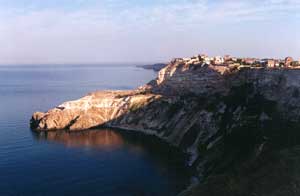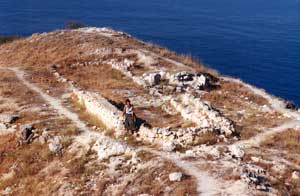
In Antiquity
In the Middle Ages
Near Outlying Areas
The Monastery of the Mother of God of Blachernai
Monastery in Sarandinakina balka
Zefir-Koba monastery
Monastic complex at cape Vinogradnyy
Caves near Skala Svyatogo Yavleniya
Fortress of Cembalo
Cave town of Kalamita or Inkerman
Syuyren' fortress
Monastery on the island in Kazach'ya bay
Far Outlying Areas

In the late Medieval period, a number of small laurai, or monastic hermitages, was formed in the outskirts of Cherson (medieval name of Chersonesos), in the Gerakleyskiy (Russian for "Herakleian") peninsula and, probably, in the other areas of Taurica (Crimea).
There is a cluster of sites in the steep south-west seashore of the Gerakleyskiy peninsula, which has its own microclimate: on the one hand, it is protected from the cold winds from the north, and, on the other hand, intensive wind-erosive processes constantly cause the rock to peel, masses of earth and rock to fall, landslides, too. These factors seems to take places in the past similarly to present, in result of which no farming estates were discovered in these terraced slopes, though such estates were typical for the outlying areas of Chersonesos in the Gerakleyskiy peninsula. The monks obviously were the only ones who dared to live there.
 Remains of a church at cape Vinogradnyy |
One of these monastic complexes in the south-west coastal area was located at cape Vinogradnyy (Russian for "cape of grapes"). It contained constructions raised above the ground, namely one-apsidal church, covered courtyard with two fireplaces, one household room, and two small cells annexed to each other, as well as cave constructions. |
Cave complex consisted of several rooms, carved in a steep of the cliff along the perimeter of a large grotto and grouped at three sides of a courtyard: room with a spring, three-partite refectory with storeroom, room with projected rock used as a bench, and kitchen with two hearths. There were three pits cut in bedrock floor of the courtyard: one was used for melting metal, and the other was double and most likely served as a winery. A vault with two burial chambers was carved in the east corner of the complex.
The lack of cultural layers and the long use of caves do not allow the scholars to determine the exact date when the complex was founded and to interpret its original purpose. What they know for sure, the vault already existed there in the late 6th or the first thirty years of the 7th century. The part of the complex that stood on the surface of the earth fell in conflagration in the 14th century, though the cave constructions probably lived until the 15th century.